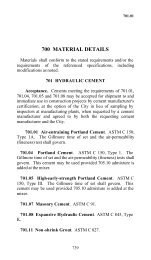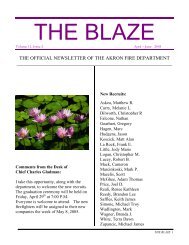Akron Water Pollution Control Station No Feasible Alternative
Akron Water Pollution Control Station No Feasible Alternative
Akron Water Pollution Control Station No Feasible Alternative
Create successful ePaper yourself
Turn your PDF publications into a flip-book with our unique Google optimized e-Paper software.
water quality models. In most cases, the racks no longer overflowed, as<br />
expected.<br />
Another measure that is important when examining sewer separation is the<br />
increase in storm water flows to the receiving waters. With separation, storm<br />
water flows that were originally captured by the racks and sent to the WPCS<br />
would no longer be captured. While separation would almost eliminate overflows<br />
at the racks, there would be a substantial increase in storm flows to the receiving<br />
waters.<br />
The reduction in the overflow volumes, events, and hours of overflow at each<br />
rack were determined. Included is the corresponding storm water flows (totaling<br />
1774.4 MG). Rack overflows were reduced from 779.3 MG to 149.7 MG. Rack<br />
40’s overflow was reduced by 251.4 MG, and secondary bypass at the WPCS<br />
was reduced by 508.6 MG. The overall reduction in overflows and bypass was<br />
1389.6 MG. Overflow events were eliminated at all but six racks (40, 29, 18, the<br />
diversion chamber, 16 and14). In 1994, four major rainfall events triggered the<br />
overflows, even with sewer separation.<br />
Another important consideration with respect to the success of sewer separation<br />
concerns footer drains as well as unidentified direct connections. It is well<br />
recognized that sewer separation results do not measure up to original<br />
expectations because of the impractical and improbable footer drain removal<br />
success. Sewer separation has been implemented many times without<br />
addressing footer drains. This is driven by the cost prohibitiveness of<br />
removing/rerouting footer drains. Consequently peak flows in “separated sewer”<br />
areas remain high and are unsuccessful. The inability to accurately identify and<br />
remove from a sewer system all storm water connections in urban areas also<br />
contributes to the lack of success with sewer separation projects.<br />
Cost estimates performed for system-wide separation found this improvement<br />
would be prohibitively expensive. Implementation of this improvement would<br />
cause lengthy disruptions to traffic and other utilities, along with increased noise<br />
and construction traffic in every combined sewer area of the City. In addition, the<br />
recreational water quality benefit in terms of attainment of water quality standards<br />
from system-wide sewer separation was found by the model to be insignificant,<br />
and the overall biological water quality benefit is not predictable. Based on<br />
insignificant water quality benefits of system-wide separation, the recreational<br />
benefit of partial separation via inflow removal would also be insignificant.<br />
However, inflow removal (defined as partial separation) remained in the<br />
alternative matrix as a cost-effective means to eliminate or reduce the wet<br />
weather volume reaching selected racks.<br />
4.3.2.2. Express Sewers<br />
The Facilities Plan 98 6 in Section 13.2.3.2 and associated supporting documents describes the<br />
methodology and resources used to develop the capital, O&M and present worth costs for<br />
express sewers CSO control. A summary of these resources and methods follows.<br />
Page 4-16







